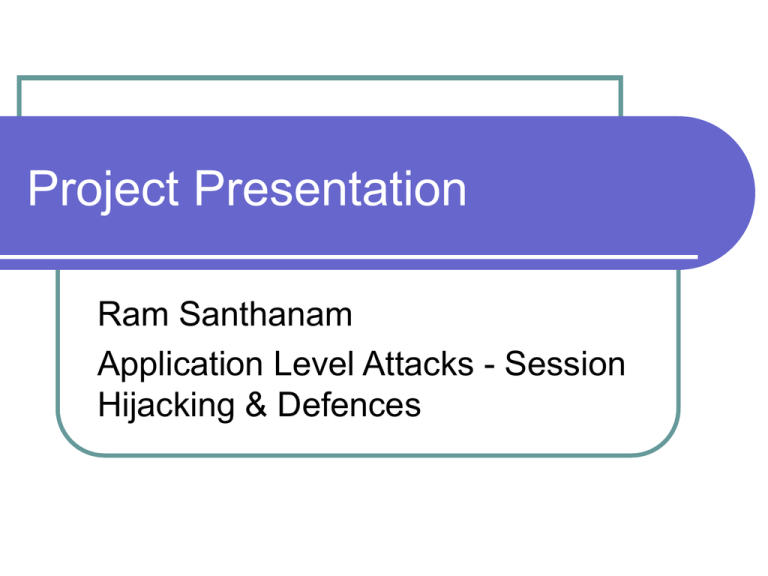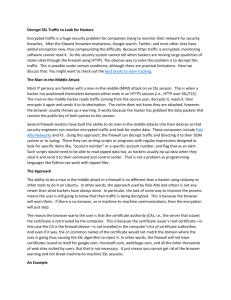Session Hijacking
advertisement

Project Presentation Ram Santhanam Application Level Attacks - Session Hijacking & Defences What is a session? Definition from FOLDOC Typically maintained by the server Includes a data store or a table to store user state and other user specific information Includes an index to the table (aka session key or session-id) Created on first request or after an authentication process Session-id exchanged between browser and server on every request. Different ways to exchange session-ids A lasting connection between a user (or user agent i.e. browser) and a server usually involving the exchange of many requests URL Rewriting Hidden Form fields Cookies (most common) Hijacking Stealing of this session-id and using it to impersonate and access data Passive attack difficult to detect Typical Session 1: Request Connection 2: Create Session 3: Session Id Client (Browser) 5: Validate Session 4: Subsequent Requests (Session id passed) Server 6: Retrieve Session Data 7: Successful response Session Data Attack Methods Guessing Session Id Session Fixing same subnet as client or server Man in the Middle Attack (SSL) trusting private networks, vulnerabilites in web servers, etc Session Sniffing (typical on non SSL sessions) predictable, session created before authenticated Security Vulnerabilities in Hops shorter length, predictable ARP Poisoning, DNS Spoofing Cross Site Scripting (XSS) User trusting source, application vulnerability Session Sniffing 1: Request Connection 2: Create Session 3: Session Id Client (Browser) 5: Validate Session 4: Subsequent Requests (Session id passed) Server 6: Retrieve Session Data 7: Successful response sniff Request (session-id) Successful Response Hacker Session Data Man in the Middle Attack 1: Request HTTPS Connection 2: Request HTTPS Connection 4: Provide HTTP Response 3: Provide Server Certificate With public key Client (Browser) 5: Subsequent Requests Hacker Machine 1 Server 6: Forward Request Request (session-id) Wait for Session to be created Pass Session Id Successful Response Hacker Machine 2 Cross Site Scripting (XSS) Hacker inserts a rogue script to a trusted site. Common in social / community sites. Defence Methods Educating the users Using high entropy in session id generation (see Tomcat e.g.) reduce window of vulnerability Using Context data for validating session-ids. limit damage if session is hijacked Re-generating session-ids difficult to sniff Forcing Re-authentication or step-up authentication reduce window of vulnerability Using SSL for all communications Higher the entropy more difficult to predict Timing out sessions Paying attention to https vs. non-https Properly signing out Not clicking on links but copying and pasting them. make it difficult to use a hijacked id Input validation prevent XSS and other vulnerabilities Tomcat Session Id generation The session id is generated through by a random number. For random number generation, Java's SecureRandom class is used. This class provides a cryptographically strong random number generator using DSA/RSA/MD5 or SHA-1 The seed (64 bit) for generating the random number is constructed by bitwise xoring the system time with an entropy string The entropy string comes from a hash value constructed from the device drivers running on the server. Using the SecureRandom class a 16 (128 bit) byte random number is generated. A one way hash of the random number is performed. A 32 byte (256 bit) hexadecimal number is created from by taking 4 bits at a time from the 16 bytes. This 32 byte (256 bit) is used as the jsessionid Questions?











